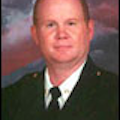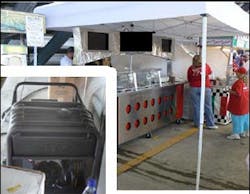Maintaining Fire and Emergency Protection at Large Venue Events
Almost everyday throughout the United States there are large venue entertainment events that are attended by hundreds or, in many cases, thousands of spectators, sport teams, athletes, event associated personnel and media representatives. Not only do the sheer numbers of attendees pose a challenge to fire and emergency responders but the event type, venue and location can present its own set of hazards.
Spectator Hazards
Numerous hazards exist that could affect the safety of attendees at these types of
events. Overcrowding of grandstands, skybox and luxury suite areas with confusing exit
access pathways can create panic in the event of emergency situations that can lead to injury and death to spectators. Panic can even occur if there is not an actual hazard but a perceived hazard. To combat these conditions, attendees should be regularly advised of emergency and evacuation procedures in the event of an emergency occurring. Procedures should be relayed in the form of announcements or televised video presentations on monitors, LCD screens or other video devices with easy to understand wording and graphics to inform occupants.
Safety announcements should contain emergency procedure information such as exit paths, exits and areas of refuge within and on the exterior of the venue. Other information such as first aid stations, severe weather notifications and in cases of venues with sound decibel issues (auto-races, music concerts, etc.) visual events or cues that will occur should also be included. Announcements should be broadcast at regular time intervals before an event in order to inform patrons arriving at different times and be broadcast numerous times during the event to continue to remind patrons of safety procedures.
All areas of the venue designed for the seating or standing of spectators should be posted with clearly defined occupant loads and penalties if those loads are exceeded. Areas should be regularly patrolled by fire and emergency personnel during an event to ensure occupant loads are enforced and maintained. Personnel should also be trained to look for hazards such as food service hazards including Sterno warmers, food warming and cooking units and concessions. Aisle and exit obstructions and other inherent hazards of the venue should also be patrolled. If any hazards are found, the condition should be immediately corrected. If warranted, fines and penalties should be assessed after the event has ended.
Plans should also be made in addressing situations occurring involving criminal activity such as assaults, intoxicated individuals, theft and other crime related incidents. Planning and involvement of law enforcement personnel is essential in controlling and mitigating these types of incidents.
COORDINATION Venue Staff and Incident Command
Another issue affecting emergency personnel is a lack of emergency preparedness and planning by venue owners and operators. The lack or inconsistency of plans can create disastrous results if in the event of fire, natural disaster, structural collapse or terrorist attacks.
Fire and emergency personnel must be involved in pre-planning for events and training of venue staff and security personnel of their roles in the event of an incident. Emergency planning should be conducted well in advance of the event and must be thorough to address any type of incident that could occur. As a matter of training, venue staff and security personnel should also receive National Incident Management System (NIMS) training and be a part of the venue's incident command staff.
A command post should be set up to control any incidents. The command post does not necessarily need to be set up at the venue, provided training and planning are sufficient to maintain an effective incident command system. (The author believes the command post should not be at the venue due to fire, natural disaster or terrorist event possibly knocking out the command post as well). The command post should be staffed with all agencies that will be involved if an incident and action planning should be unified.
Communications should be maintained from the command post and information should be regularly disseminated throughout the command structure of the event. Radio frequencies should be utilized that are common to all event personnel and radio communications should utilize clear text to eliminate the possible confusion of 10-codes.
Sport Teams and other Support Personnel
Hazards exist to sport teams, participants, athletes and other support personnel involved and participating in the event. Often these personnel are oblivious to hazards that may affect them or their fellow teammates. Emergency personnel are often chastised or treated with great disrespect by these persons and the arrogance, ignorance and bigotry often pose great challenges to rescue crews. Arguments and confrontations should be avoided with these individuals as much as possible and rescue personnel should attempt to create contacts and alliances with the sanctioning bodies or promoters of events. These alliances can be used during times of conflict to encourage participants to follow safety rules and play nice.
Another way to attempt to overcome issues occurring with athletes and sport teams is to arrange meetings with them months prior to the event and explain reasons for safety policies and procedures. From these meetings partnerships and friendships can be made. Often times communication issues and a lack of understanding on both sides create problems at the event. Meetings before the event allow all involved parties to explain their sides of conflicts and happy mediums can be made thus avoiding confrontations at the event.
The handling of flammable and combustible liquids, fire effects, pyrotechnics and other event specific special effects should be permitted and inspected by code enforcement personnel. Credentials of all technicians involved should be checked and any required federal, state or local government licenses should be verified before a permit is issued. A thorough investigation of how effects are to be ignited, the intended use, duration and fire extinguishment procedures should be conducted. If necessary, fire personnel should be staged with fire extinguishing equipment to extinguish any fires resulting from effects.
Any events that pose rescue and impact hazards to participants such as auto racing, monster truck competitions, motor cross or other type of vehicle-related events should be properly planned. Fire and emergency personnel should be properly trained in the safety procedures of what locations to enter the track or field and under what conditions. Personnel should also be properly equipped with the necessary extrication tools, communications equipment, personnel protective equipment and knowledge needed to safely shut down any vehicle and rapidly rescue the driver or rider.
Venue Hazards and Inspections
At times the age of the building, theater, coliseum, grandstands or stadium creates hazards to occupants. Advancements in building and fire codes throughout the years without retrofit requirements have left many of the venues with a hodgepodge of fire protection, exit access and discharge routes, kitchens and concession cooking and serving methods. (The author's jurisdiction has a venue that was built in the 1960's with numerous additions and remodels throughout the years - all creating an enforcement nightmare.) Many times code officials are forced to enforce regulations by the building/fire codes that were in effect at the time of construction. This often times leads to confusion and creates confrontations with venue owners and concession operators at the time of events.
The venue should undergo fire and life safety inspections at regular intervals. All violations and deficiencies should be corrected prior to any event. Areas such as fire lanes, exit access corridors, doors and exit discharges, occupant seating and aisles, food concessions, kitchens and service areas, fire protection systems and alarms, and electrical/HVAC rooms should be focused on along with any other venue specific areas, systems or conditions. During events these same areas should be checked to maintain code compliance. Many times these same areas become tampered with, obstructed, altered or damaged, cluttered or hazardous during events. Any conditions found by code personnel should be immediately corrected or rectified. Props, backdrops, scenery and other associated equipment should be inspected for flame resistance and placement during use and storage. These items cannot be allowed to be stored or potentially block paths of egress. Fines and penalties if necessary should be assessed after the event has ended.
Prior to the event, all private concession contractors, souvenir sales vendors, tents and other venue specific sales and display locations should be issued permits, inspected and code compliant before being allowed to begin sales to the public. Any venders not complying should not be allowed to open and, if necessary, fined and removed from the event. A simple method to avoid these issues is for code enforcement authorities to develop informational flyers and brochures detailing permitting requirements, inspection and Code compliance issues.
These items should be given to event coordinators during the planning phase of the event to distribute to sales and display vendors. Tents, recreational vehicles (RVs) and campers with other camping associated paraphernalia also create issues for fire and emergency personnel. Adequate fire lanes and spacing must be maintained to eliminate fires spreading from unit to unit. Fire personnel should make regular patrols through these areas to ensure carelessness with fire is not occurring. Patrols should also keep watch for excessive trash and debris that could lead up to fire spread as well. Upon finding any of these issues, personnel should immediately order the situation corrected and if necessary, fines and penalties should be imposed.
Events occurring over several days may dictate fire and emergency services manning a temporary, 24-hour-a-day station to maintain fire and EMS protection of patrons and participants at the event. Budget salary figures should be adjusted to meet overtime pay and compensation for personnel assigned to work during events. Fees and venue permitting requirements may be need to implemented provide funding to meet these additional personnel cost. Once again, meetings and partnerships should be made with venue owners and operators to explain regulations and requirements months prior to events occurring. From these meetings partnerships, plans and solutions to problems can be developed, implemented and maintained.
Conclusion
Large venue events are an everyday occurrence and are rapidly becoming more diverse, larger and more prevalent. Fire and emergency personnel must continue to be involved in event
planning, training and safety enforcement. Emergency preparedness, fire safety and code compliance must continue to be stressed to venue owners, operators, vendors, patrons and participants. Proper implementation of all of these measures will create and maintain a safety conscious environment before, during and after a large venue event.
MARK A. BROWN, a Firehouse.com Contributing Editor, serves as Fire Prevention Bureau Chief for the Concord, NC, Department of Fire & Life Safety. A 20-year veteran of the fire service, he is an appointed board member of the North Carolina Fire Marshal's Association and possesses an Associates Degree in Fire Protection and is. To read Mark's complete biography and view his archived articles, click here.
About the Author

Mark Brown
Mark A. Brown has been involved in the fire service for 19 years and currently serves as Fire Prevention Bureau Chief for the Concord Department of Fire & Life Safety located in Concord, North Carolina.
Since becoming a firefighter in 1987, he has been promoted through the ranks of the fire department and has served numerous positions including fire training officer and fire marshal. Mark has assisted the North Carolina Office of the State Fire Marshal in the development of the Hazardous Materials Technician Certification Program and currently assists in the instruction and delivery of the program.
Mark possesses numerous certifications in several different fire department disciplines including Firefighter Level II, Fire Inspector Level III, Fire Instructor Level III, Hazardous Materials Technician/Transportation Specialist and WMD Technician. He possesses an Associates Degree in Fire Protection and is also a recently appointed board member of the North Carolina Fire Marshal's Association.
